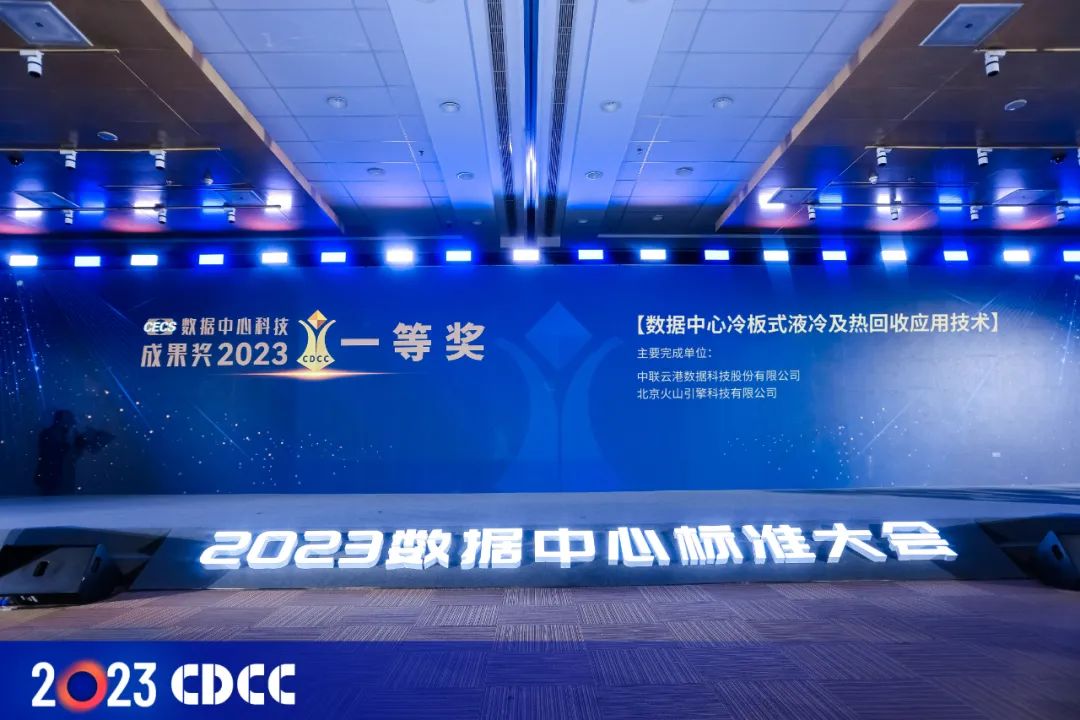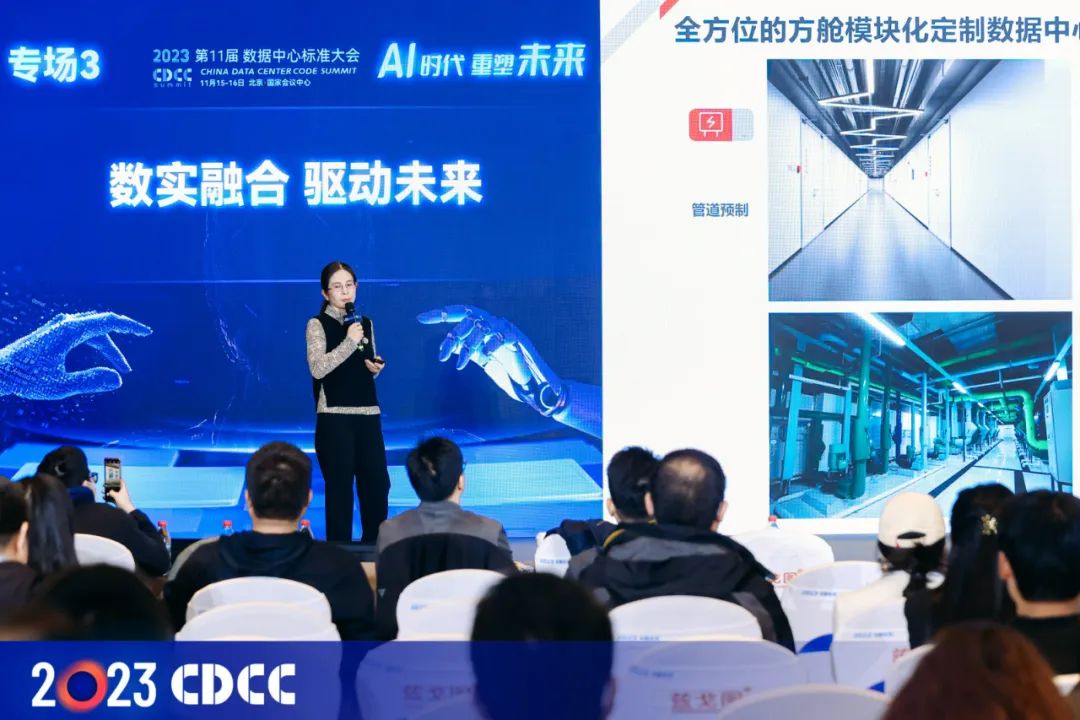ZDATA Group and Volcano Engine R&D Innovation won the first prize of the 2023 Data Center Technology Achievement.
On November 16th, at the 11th Data Center Standard Summit hosted by CDCC, the 2023 Data Center Technology Achievement Award was announced. The jointly developed innovation "Data Center Cold Plate Liquid Cooling and Heat Recovery Application Technology" by ZDATA Group and Volcano Engine achieved a major breakthrough in the industry with its advanced innovation and developmental applicability, earning the first prize.

The 11th Data Center Standard Conference in 2023, themed "AI Era: Reshaping the Future," delved into the key elements of sustainable development of data centers from a forward-looking perspective, opening a new journey for the high-quality development of green computing power.

Du Lina, Technical Director of ZDATA Group, delivered a speech entitled "Designing to Facilitate Carbon-Neutral Data Centers."
The Data Center Achievement Award is a prestigious industry award approved by the Office of the National Science and Technology Awards of the Ministry of Science and Technology and organized by the China Engineering Construction Standardization Association. It is a highly regarded industry award in the field of data center technology. The "Data Center Cold Plate Liquid Cooling and Heat Recovery Application Technology" jointly applied by ZDATA Group and Volcano Engine won the first prize after multiple rounds of rigorous expert review and evaluation. This not only recognizes the technical leadership of ZDATA Group and Volcano Engine in the data center industry but also fully affirms their joint innovation and development with customers.

Cooling + Heating, Supporting High-Quality Computing Power Development Bidirectionally
With the development of emerging technologies such as artificial intelligence and large models, the demand for AI computing power has shown explosive growth, and chip performance iterates rapidly, posing new challenges to energy saving and heat dissipation in data centers. Traditional air-cooled air conditioning technology can no longer meet the cooling requirements of high-power cabinets. The "Data Center Cold Plate Liquid Cooling and Heat Recovery Application Technology" uses cold plate liquid cooling technology to cool high-power servers by producing medium-temperature chilled water through dry coolers and then distributing it through piping, CDUs, and manifold devices. At the same time, it integrates heat recovery technology to recover the waste heat in the data center, converting it into heating hot water and transferring the data center waste heat to buildings or equipment in need of heating through piping networks and new heating terminals, thereby changing the current situation of directly emitting data center waste heat into the atmosphere through air conditioning systems and further turning waste heat into valuable resources. This technology, combined with the current situation of data centers and customer needs, has been applied in the first-phase data center of China United Green Cloud Valley Industrial Base, with an annual average PUE as low as 1.15, providing customers with safe and reliable green computing power while achieving better economic and social benefits.
01 Cold Plate Liquid Cooling Technology
On the liquid cooling side, chilled water is produced through dry coolers, and servers are cooled using piping routes, CDUs, and manifold devices on the primary and secondary sides; the cold source on the air cooling side uses indirect evaporative cooling chillers, which can produce water about 3°C lower than the outdoor wet bulb temperature. Thin plate air conditioning units are used at the air conditioning end, and the air walls and cabinets are installed in parallel to form closed hot aisles. Both liquid cooling and air cooling sides use medium and high-temperature chilled water, combined with meteorological parameters in Datong, which can achieve natural cooling throughout the year.
02 Data Center Heat Recovery Technology
The data center heat recovery combines water-source heat pump technology with heat recovery evaporative cooling fluorine pump air conditioning technology. The water-source heat pump uses the return water of the air conditioning system as a high-temperature water source, greatly improving the efficiency of the heat pump; the heat recovery evaporative cooling fluorine pump air conditioning technology can directly recover heat from the closed hot aisle, breaking through the conventional mode of heat recovery technology can only perform large-scale heat recovery from the water system; this technology can achieve higher heat recovery rates from both the data center water system and the air system. At the same time, the heat recovery evaporative cooling fluorine pump air conditioning unit can effectively reduce the condenser inlet temperature of the air conditioning unit in summer through evaporative cooling technology, achieving a lower CLF value than indirect evaporative cooling air conditioning units.
03 Containerized Diesel Generator Composite Heating and Insulation Technology
On the basis of retaining the electric heating of the engine cylinder liner cooling liquid, a plate heat exchanger is set up to exchange heat between the recovered hot water and the engine cylinder liner cooling liquid, circulating and heating the cylinder liner cooling liquid to meet the heating needs of the diesel engine; the hot water heating system and the electric heating system are in parallel mode, with priority given to hot water heating and electric heating as emergency backup heat sources, realizing the utilization of waste heat instead of high-grade electrical energy.
ZDATA Group will continue to accelerate its exploration on the path of "zero carbon + computing power," continuously promote self-research and innovation of liquid cooling technology and other related technologies, and lead the green and efficient development of the data center industry into a new ecology.
Recommended News
-
02/032022
Tiger Year's Eve Doesn't Rest - ZDATA Faces Extraordinary Challenges in Ordinary Production Positions
Entering the Chinese New Year of the Tiger in 2022, ZDATA, adhering to its consistent high-reliability service standards, once again excelled in ensuring operational security and received praise from clients. The company maintained a new record of "zero incidents" during the Spring Festival. -
12/112024
Secretary of the CPC Hebei Provincial Committee, Ni Yuefeng, visits the Zhangjiakou Green Intelligent Computing Industrial Base of the Zhonglian Data Group
On December 3, Ni Yuefeng, Secretary of the Hebei Provincial Party Committee and director of the Standing Committee of the Provincial People's Congress, visited the Zhangjiakou Green Intelligent Computing Industry Base of China United Data Group to inspect the construction situation of the base in detail, and conducted in-depth research on promoting the development of digital economy in Hebei Province.

